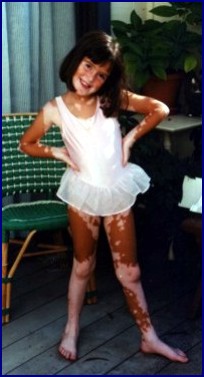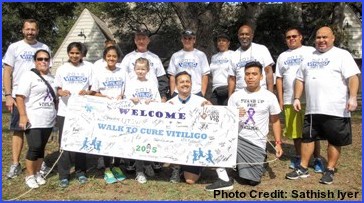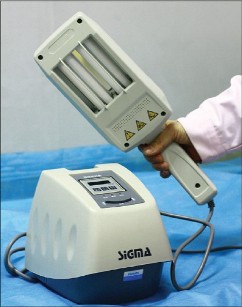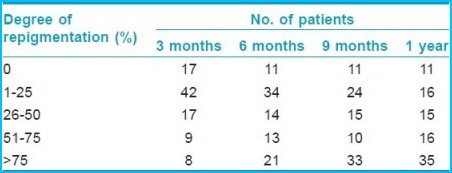| Best View Click Here To Read From VSI Website |
 |
|||||||||||||||||||||||||||||||||||||||||||
This Newsletter Has Been Generously Sponsored By: 
Click Above for More Information on Home Phototherapeutic Light Units for Vitiligo
|
|||||||||||||||||||||||||||||||||||||||||||
|

Dear Members and Friends of VSI, Whether you’re young or old, or whether you or someone you love has vitiligo, everyone whose lives have been touched by this disease know what it’s like to encounter a difficult or uncomfortable situation. Sure, it can be difficult when facing stares or rude comments; however, there is no reason to be ashamed of something for which you have no control. Vitiligo is an autoimmune disease that causes pigment loss. Type 1 diabetes and rheumatoid arthritis are also autoimmune diseases. Would you be ashamed if you had one of those diseases? Of course not. Many, if not most, inappropriate comments are simply the result of ignorance or misinformation. VSI once received a phone call from a woman wanting to know if she could catch vitiligo if she ate cookies made by her neighbor with vitiligo. She was especially concerned because the neighbor had touched the cookies with her depigmented hands. NO! It’s not contagious. It’s two colors of skin! The human reaction to having your feelings hurt is to strike back. However, being prepared for the situation can help not only to defuse the hurt, helping you to feel better, but can also help educate the offender. Looking at these types of experiences as educational opportunities can put you in the driver’s seat, and turn a negative into a win-win. VSI regularly receives requests from all types of media outlets for everything from casting and program production to background information and fact checking. In our previous newsletter, we reported on a segment on the topic of “vitiligo discrimination” that appeared on the ABC News national TV show What Would You Do? VSI assisted and collaborated with the show producers for several months for this production. On the one hand, it’s great to know that vitiligo awareness is growing to the extent that public interest is great enough to be a profitable commodity on a national level. On the other hand, as awareness increases, it’s all the more important to ensure that the information being publicized is presented in a positive manner and most importantly, that it is accurate. Each year as fall approaches, VSI begins receiving requests for information and support from parents of children with vitiligo. For first-time students or those just moving up a grade level, there are steps you can take to help ensure a positive start to a new school year. Whether you’re a parent, teacher, neighbor, or co-worker, everyday interactions are opportunities to help others understand that we all have differences. Diversity education is applicable from pre-school to the workplace to the broader community life. Our article in this edition, while primarily centered on diversity education in the classroom, also provides positive tips and ideas to help those who might be struggling with personal acceptance. We ask that as you read this article, you consider not only the ways that you might evoke positive change in the preconceived notions of others, but that you also keep your own mind open to personal changes you might need to make to improve in your role as a vitiligo ambassador for diversity awareness and acceptance.Sincerely,
VSI Newsletter: Changes Coming VSI’s quarterly newsletters are the only current, regularly produced and circulated vitiligo patient publication in the world. Each publication brings the very latest information available on research findings, clinical trials, treatments, meetings, and information to improve the daily lives of those affected by vitiligo.
Each quarterly newsletter requires hundreds of hours of research and manpower, VSI will be moving to a subscription-based program. Note: If you are a current Supporting Member, your newsletter subscription is
2015 Vitiligo Conference! Around 100 attendees from around the world assembled in Orange, California to enjoy each other’s company and hear the very latest vitiligo news. The event kicked off on Saturday evening with a social and dinner held at Dave and Buster’s. Participants were treated to a delicious dinner buffet followed by an evening of magic, music and karaoke. Sunday morning began with a continental breakfast and viewing of a wide variety of vitiligo abstracts presented by their authors. The main program followed with topics from potential vitiligo triggers and chemicals to avoid, to treating childhood vitiligo. After a delicious lunchtime Mexican buffet, the afternoon session concluded with aQ & A session allowing attendees to “ask the expert” any questions they had on their minds. Keep an eye on VSI’s Facebook and Community Page for a full meeting summary.
Diversity Education: With the exception of a few minor edits and updates, the basis for the following article is taken from an article entitled “Making a Difference at The Start, and All Through the School Year,”written in September 2003 by Lori Mitchell when her daughter April was entering kindergarten. Lori is an author and graphic artist, and has written and illustrated several children’s books, the most well-known being Different Just Like Me that she wrote for her daughter April, and to help children and adults alike learn to appreciate and respect diversity.
Lori and April have been members of VSI since its inception.
Making a Difference at School I find that more and more teachers have questions about how to integrate a child with special needs into the class socially. Some parents think the teacher will handle the introduction; however, with privacy laws and regulations such as the Family Educational Rights and Privacy Act Regulations (FERPA) and the Health Insurance Portability and Accountability Act (HIPAA), most school districts prohibit teachers from discussing any child’s special circumstances without first receiving permission from the parents. So days, even weeks, can go by and the child doesn't get the help he/she needs. Look for ways to start the conversation
There are as many different ways to introduce a child with a special situation into the class as there are students, but the process begins with a conversation between the teacher, the parents, and the child. The teacher may have wonderful ideas and experience or she may want ideas from the parents. Honesty seems to work the best, no matter what the approach. In our family, kindergarten was slowly approaching and my husband and I agonized over what to do for our daughter April, who had vitiligo covering about 60% of her body.
Get a Head Start
On orientation day there were kids and parents pointing and whispering, so we knew there would be questions at school. I didn't know that I could have spoken with April’s teacher to ask for help. I thought her teacher had enough going on and we should just handle this ourselves. We didn’t want to bring April up in front of her new classmates to point out her vitiligo, as she has always been very shy and never wanted much attention drawn to her. We thought about having her go out of the room while we talked about her skin, but that seemed wrong. We felt it would send the message that she was ashamed of her condition, or that it had to be a secret. So what were we to do? This way it wasn't just about her condition, We sent it home for the parents to read to their children. The next day April wore her usual shorts and T-shirt. There were a few friendly questions, but from then on she was just another kid in class.
Little Things Can Make a Big Difference
Bring Baby Pictures
Importance of Communication In fourth grade, I didn't think I needed to talk to April's teacher. A few weeks into the school year, April came home and told me two boys had been calling her and her friend bad names. I realized I needed to make sure that her teacher knew I wanted to be informed of anything like this. It’s important to keep communication open with your child. Ask them how their day went and watch for any signs or changes in their personality. April usually told me if anyone said anything about her vitiligo. I would try to just listen and let her figure out what she wanted to do about it. I think that helped her to feel like she had more control. I wasn’t going to be there every time someone said something to her so she would have to know, and feel confident, that she could deal with it on her own. If she asked for ideas, I would suggest something, but I would usually let her go through a list of her own ideas first.
Practice at Home: Role play
Anyone can say anything; that doesn’t make it true! We had to practice so she would know that she wasn't any of those things that anyone called her. We talked about how much her family and friends loved her just the way she was. We also talked about bullies and some of the reasons they might be teasing her. It could be that they were scared of catching vitiligo. It could be that they were being teased at home or they didn't feel good about themselves. We emphasized that their behavior very rarely had anything to do with the person they were teasing. The point of role play is not to come up with the one There will be different situations and your child will have to think on his/her feet. The point is to have the discussion with your child before the bully does. The bully will zero in on any shame the child might be feeling. If you can role play and have an open, honest discussion, that shame is diminished, if not totally dissolved.
Let Your Child be Your Guide Some children will be more outgoing than others. Talk with your child and provide a few ideas on what to say to the other children. Nothing formal is needed, just a few simple and honest responses, such as:
It shows that there's nothing to be ashamed of and there are no secrets. Most of the time the other kids in class just want to know more about the condition, and once they do, they feel more comfortable and know what to expect.
Other Ways to Help Your Child Explain: April came up with the idea of handing out cards explaining her vitiligo. On each card she printed, "I'm just like you; I just have two colors of skin. I’m not contagious and it doesn’t hurt." April decorated them with stickers on the back and included VSI’s website address.
The cards were a big hit, and I think made her feel like she had a little more control over the situation. As April got older she became more comfortable answering questions about vitiligo, but she still kept the cards, just in case. If your child doesn't want to say anything about their condition, don't force them to. If a child is too young or just uncomfortable to speak for themselves, there are many fun classroom games and exercises that can be used for diversity education. Classroom Diversity Education Discussions on diversity help all of the students. To prevent any one child from feeling singled out, you can talk to the class about differences in a general way, or have a day where each student gets a few minutes to tell something unique about themselves. Frequently, the students in April’s class shared personal stories about their family members that had some kind of difference and they asked questions to help them understand how to deal with different situations. For many students, this was their first opportunity to share this information. Every child in class has felt different at one time in their life and it's usually a great relief for them to know they weren’t the only one. Same and Different Classroom Exercises Helping children understand that they are each different in some ways and alike in others helps them become more accepting of differences as they go through life. Ask your child's teacher if in the first week or two of school they could have a day when every child shares things they like and like to do, and something unique about themselves and or their family. One child might explain that they just lost a tooth, another might bring a picture of a new baby sibling. They can share their favorite colors or season, or that they like to play outside or go to the zoo, or whatever they’d like, and things they like to do. When it is your child's turn, encourage him/her to share that he/she has vitiligo, telling the other children that it does not hurt, and is not contagious; it's just two colors of skin. Your child could also share things like his/her favorite color, favorite vacation, favorite holiday, etc. You can then step in and point out that each child is different in some ways and alike in others, explaining that this is what makes them special.
Bring in pictures of two similar objects that have differences, like fish.
Ask students to line up, or if class size is large, Start by saying one thing about yourself that makes YOU different from the person on your right. Go down the row and have each child say something that makes them different from the person to their right. When you get to the end, start over and have them say one thing that makes them the same as the person on their right. Remind them before you start that you want to come up with as many different ideas as possible and try not to have any repeats. Make sure that when they are saying what’s different or the same that they say “I,” not “YOU,” as in “I” am different because I have blue eyes and yours are brown.” Never Judge a Book by Its Cover Take a plain brown bag, crumple it up and fill it with lollipops, then tie it with some old string. Now fill a beautiful gift bag with toilet paper and tie it with ribbons and bows. Ask the students to pick a bag. Once the bags are opened, ask them how they think this relates to people. The children will soon begin to understand that each one of them are different in some ways and alike in others. Within a week or so, most will forget about differences, and get on with playing and learning. April’s Thoughts as a Child As I was writing this article, I asked April (at the time, around 12 years old) what she would want to share, and this is what she said: I have made a few discoveries while living with vitiligo. One is that I'm not the only one in the world that is different. Every kid in my class has something that makes them different. I think I used to wonder why I was the only one that had to be different, but now when I really take a look at everyone around me, I can see that no one is perfect. The second thing I figured out was that, so far, there's very little I can do about my vitiligo. The only choice I have is how I deal with it. I can be really angry and bothered by it, I'm going to have vitiligo whether I'm happy about it or not. Why not choose to be okay with it and focus on the good stuff in my life? If someone teases me, I'm not going to let him or her ruin my day. Some person I don't even know cannot decide what I think of myself. I have lots of friends and family members that love me just the way I am, and they count much more than some rude goof ball. Another discovery is that I am more than just my vitiligo. I'm talking about it a lot now because that's what this is about, but normally I don't really talk about it or think about it all day. I have lots of other things to think about, like my cat, drawing, singing, playing piano, my friends, swimming, homework, and shopping. April Today: Growing up with the love, support, and guidance of her parents, coupled with a mother dedicated to imparting diversity education to all those in her path, April Mitchell, now 24 years old, is a beautiful and well-adjusted young lady. Many of you have seen the model Chantelle/Winnie Harlow in the media (she competed on cycle 21 of America’s Next Top Model). She, too, has become an inspiration to many for never letting vitiligo stand in the way of her dreams. April, also quite interested in fashion, had been following Chantelle’s Instagram, and was surprised when one day the cover of her mom’s book, Different Just Like Me, appeared on her Instagram. Chantelle shared stories of being bullied as a child, and said that when she was only 7 years old, her grandmother had given her a copy of the book which really helped and inspired her as a child. April contacted Chantelle via Instagram and the next thing you know they had the opportunity to meet. Chantelle told April she almost felt like they were sisters.
They took a moment to pose with their hands over the book.
Different Just Like Me can be found in most The book shows how we are all different, yet still very much alike. It is recommended for kindergarten through third grade, but the lessons and activities have been used in classes all the way up to 10th grade. Lori Mitchell donates ten percent of the book proceeds to Vitiligo Support International. For additional information and classroom resources visit: Different Just Like Me
On October 3, 2015, the Dallas/Fort Worth Support Group held its second Vitiligo Walk-a-Thon to benefit VSI, at Bachman Lake in Dallas, TX. The combined efforts of multiple community sponsors and 120 walkers yielded nearly $8,000. The proceeds will go toward VSI’s programs and services, which offer support and educational resources to the vitiligo community and promote vitiligo research and awareness. The Dallas/Fort Worth Support Group was started in 2012 by Medha Iyer at the time, an 8th grade student. She and her family approached Dr. Amit Pandya with an idea that has since grown to become one of the most successful vitiligo support groups in the country! According to Dr. Pandya, Medha (now a senior in high school) and her family have played a critical role in the success of the support group, even helping to create a website. VSI greatly appreciates all the efforts of Walk-a-thon organizer Lucio Zapata, Jr. (research assistant to Dr. Pandya), the walkers, and others responsible for the success of the 2015 Walk-a-thon, as well as the support from the sponsors, the community, and the friends and family of the walkers. The 2016 Dallas Vitiligo Walk-a-thon is scheduled for October 1, 2016.
What's On Your Mind? Q. Is Vitiligo Contagious?
Q. Will my Children Develop Vitiligo?
Highlights of recently-published medical Narrow-Band Ultraviolet B Home Phototherapy for Vitiligo While NB-UVB phototherapy only takes a few minutes for the treatment itself, it can become very difficult if the patient has to interrupt their work or school schedule with travel to and from an office or hospital, two or three days a week for many months at a time to obtain the treatment. In an effort to reduce the barriers of this type of treatment, home NB-UVB phototherapy was introduced in 1979. This study was aimed at discovering if home phototherapy was as effective as conventional “in-office” or hospital-based phototherapy treatment. 93 vitiligo patients (46 males and 47 females) were enrolled in the study, with none having prior experience with home phototherapy. Training time was minimal (no longer than 30 minutes) for the patients, or the parents of younger patients. Participants were examined and photographed at the onset and every 3 months for one year to assess progress and side-effects. Regardless of skin type, all patients were started at the same dose of 0.3 J/cm2, with treatment times being increased by 0.1 J/cm2 each time, until they reached the desired erythemal (pink) response. Treatments were given every other day, three days a week. Not all areas of the body have the same response time. For instance, the feet and hands require greater exposure times to obtain the same (optimal) erythemal reaction as other areas of the body, such as the face. Another benefit of using the smaller device was the ability to easily adjust treatment times as needed for the different areas of the body. Side effects were minimal, resulting in strong compliance and no participants dropping out of the study. Eleven patients reported burning or itching, and 6 reported dryness of skin; however, these problems were corrected by adjusting the treatment time and/or applying moisturizers. The patients with a poor response during the first three months showed no further improvement during the study. The table below details the response time of the 93 participants
It was noted that some areas of the body achieved greater results than others, with the best response (excellent repigmentation) on the face and neck for 27 of 36 participants. That was followed by 16 of 43 participants with torso lesions, but only 2 of 29 participants with lesions on the feet and hands.
Even when factoring the additional treatment time required by use of the smaller hand-held device for those with more widespread lesions, the convenience far outweighed the total time, cost, disruption, and overall inconvenience of the alternative. The study authors concluded that home phototherapy is safe and cost-effective, with results similar to hospital-based phototherapy.
Early-Onset Childhood Vitiligo is Associated In July 2015, researchers at the Ronald O. Perelman Department of Dermatology, New York University School of Medicine, released findings of a retrospective review of the charts of 208 pediatric patients seen for vitiligo between January 1, 1990 and November 15, 2014. In order to accomplish the goal of comparing clinical features and characteristics of early-onset and later-onset vitiligo, the researchers divided the children into 2 groups. The early-onset group were those diagnosed before the age of 3, and the “later-onset” group were those diagnosed between the ages of 3 to 18 years. They observed that the early-onset group had a much higher percentage (6.3%) of body surface area (BSA) involvement, compared to the later-onset group which had only 2.6% BSA involvement. When following up, on an average of 1.9 years later, they found that over half (56%) of the early-onset patients experienced new areas of pigment loss, compared to only 35% in the later-onset group. Their findings indicated that children diagnosed with vitiligo before the age of 3 were more likely to experience more progressive and extensive disease than those who develop vitiligo at a later age. These findings would seem to corroborate the recommendation of multiple research studies indicating that the earlier treatment is offered, the more successful the outcome. Editor’s note: In previous studies, early onset vitiligo has been discussed as that beginning prior to the age of 10-12, depending on the study. Perhaps since these researchers were only looking at pediatric patients, for the purposes of this study, they altered the customary age ranges.
New Phototherapy Study in Baltimore MD
Segmental Vitiligo Study in Detroit MI and Worcester MA
Autoimmune Vitiligo Study in Detroit
Needling Clinical Trial in New Jersey
Melanocyte-Keratinocyte Transplant Procedure
A Special Call To Segmental Vitiligo Patients
NEW! - Support VSI Through Ebay
Earn Funding for VSI 3 Ways When You Shop! Please keep VSI in mind when you do any of your online shopping
|
||||||||||||||||||||||||||||||||||||||||||
| Copyright © 2015 Vitiligo Support International Inc. All rights reserved. Reproduction or republication strictly prohibited without prior written permission A Vitiligo Support International, Inc. financial statement is available upon written request from the Virginia Office of Consumer Affairs. Mail requests to: Virginia Department of Agriculture and Consumer Services, Office of Consumer Affairs, P.O. Box 1163, Richmond, Virginia 23218. Click here to unsubscribe |
|||||||||||||||||||||||||||||||||||||||||||
























